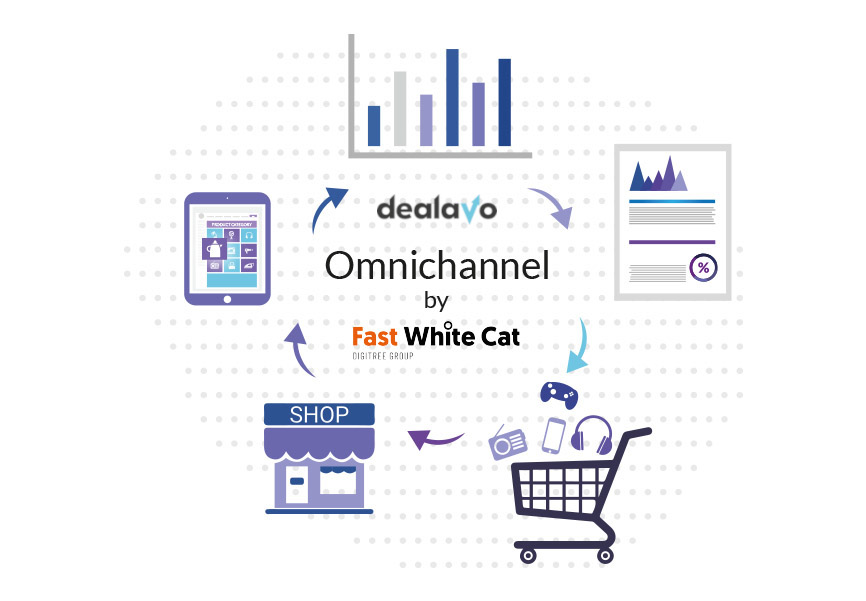First of all – sales. A few words about omnichannel
- 22 July 2020

Brands who understand the potential of eCommerce know that one of the most powerful weapons to sell effectively online is the omnichannel approach. Consistent messages to consumers are important and have an impact on building brand awareness among them. How to improve omnichannel in practice?
Rising charts with omnichannel
According to the 5th edition of the report “Omni-commerce. I buy conveniently”, currently 27% of Internet users (and even 38% of people over the age of 35) declare that due to the still existing risk of contracting coronavirus, they shop online more often. The data shows that both eCommerce and traditional sales are doing quite well and work well together – consumers often choose both channels, and this is one of the reasons why omnichannel should be a strong branch of marketing. Fast White Cat, an unusual eCommerce Software House, which not only builds and programs its clients’ e-shops but also cares about growing sales on these platforms, thanks to the introduction of the omnichannel strategy, it successfully increased its clients’ revenues – in the case of Quiosque by as much as … 500%.
How to make omnichannel work?
Omnichannel is an approach in which we use various sales channels and combine promotional activities. We do it simultaneously and therefore effectively. In practice, this means consistent activities in paid advertising campaigns, e-mail marketing, social media promotion, communication in mobile applications, and other tools used by eCommerce. The number of integrated tools that we use to promote and communicate the brand is directly proportional to the number of consumers who purchase in our store – that’s why we recommend full integration. What’s more, omnichannel can be further improved by using dedicated tools.
How to implement the omnichannel strategy?
To successfully implement the omnichannel strategy, it is necessary to get to know the customers’ paths-to-purchase, which can be non-obvious and complicated. Buyers often first search for information about products online, then compare prices and shopping conditions, and finally place an order, for example, additionally using a discount code received by e-mail. What is more, customers already at the stage of searching for information most often use several sources – they read opinions, read posts in social media, watch video reviews, or use applications. Therefore, it is worth making sure that both communication and price are consistent in all channels, as this builds trust in the seller, which is extremely important for the eCommerce channel.
How to support the omnichannel strategy with appropriate tools?
In the case of the synergy of various communication and sales channels, the key is to monitor whether our strategy is implemented – otherwise we can be going towards a completely different effect than the intended one and not even know it. This is especially important in the case of prices – the customer, seeing significantly different prices in various channels, feels misled, and does not see the true value of the product.
To better understand the need for monitoring, let’s consider some of the customers’ paths-to-purchase. Consumers currently move smoothly between channels such as online stores, brick-and-mortar stores, social media, stores or manufacturers’ applications, and marketplaces such as Allegro or Google Shopping, and their shopping paths have many points of contact with the product. For example, when wanting to buy a vacuum cleaner, the consumer will first browse the offers of online stores online, then view the products in a brick-and-mortar store, then read the opinions online, and purchase in an e-store offering the best price and sale conditions. It is a very simple path, and it already has 4 touchpoints that affect the final purchasing decision. If a consumer notices large differences in online vs offline prices or product reviews, it can reduce their confidence in the store or brand. With the use of an online tool for online and offline price monitoring, this will not happen – both the store and the manufacturer on the same day may notice any significant differences between channels or comparing to the competition and act accordingly.
In the case of brands running their eCommerce, monitoring can prevent proposing lower prices than retailers accidentally, and also help to define those partners who offer prices and terms of sale that are the most similar to the producer’s strategy. This allows, for example, to define the best stores to launch a new product on the market. In the case of eCommerce, thanks to online and offline competition monitoring, we can compare our strategies with the competition and, if necessary, make the appropriate changes – may be the prices of vacuum cleaners are similar online, but they differ significantly in neighboring physical stores? It is worth looking into.
Another aspect of omnichannel is click and collect programs, i.e. placing an order over the Internet or by phone, and then picking it up in the store. They are often competitive with online shopping, especially for more bulky products that are more expensive to ship. When choosing an eCommerce monitoring platform for online and offline sales, it is worth paying attention to whether it is also possible to collect data on the availability of products in individual stores through click and collect.
If you manage eCommerce and implement the omnichannel strategy, you will need tools to monitor such data as prices and availability of products, also in the click and collect option or promotions in individual stores, also in the case of loyalty programs and discount codes. If you combine the help of a specialized company with many years of experience of Fast White Cat, along with a price monitoring platform that focuses on data quality and customer service like Dealavo, your omnichannel strategy can bring even three-digit increases in sales conversions.
Learn more about factors you should analyze when deciding about the optimal sales and promotion channels for your business: Which products to sell and promote on the most important e-commerce platforms?